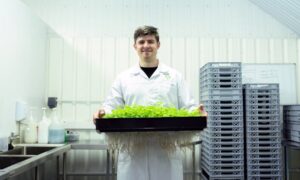Welcome to the forefront of agriculture, where the fusion of science and nature promises to reshape crop yields and address the escalating global food demand. In this blog post, we will explore the realm of genetic engineering, unlocking its potential as a game-changing tool for farmers worldwide. Join us as we unveil the secrets embedded within DNA strands and examine how these revelations are reshaping our approach to food cultivation. Prepare to witness how genetic engineering is empowering agriculture to amplify crop yields like never before!
Introduction:
Understanding Genetic Engineering
Genetic engineering entails the manipulation of genes to alter an organism’s characteristics, applicable to plants, animals, and even microorganisms. By modifying the genes of crop plants, farmers can confer resistance to herbicides or pests. This innovation reduces the need for chemical treatments, benefiting both the environment and farmers’ profitability.
Beyond bolstering resilience, genetic engineering can enhance yields. To meet the increasing demand for food while conserving resources, scientists introduce new genes into crop plants to accelerate growth, increase size, or enhance fruit and seed production.
While the potential of genetic engineering in agriculture is exciting, it’s vital to acknowledge that this technology is relatively recent and carries inherent risks. As with any emerging technology, unforeseen consequences are possible. Nevertheless, with responsible and cautious implementation, genetic engineering holds the potential to transform agriculture sustainably, meeting the ever-expanding food needs.
Genetic engineering is a potent technology for improving crop plants’ resilience and yield. While associated risks exist, judicious deployment can boost food production in an eco-friendly manner.
Advantages of Genetically Engineered Crops
Genetically engineered crops offer numerous advantages. One of the most promising benefits is increased crop yields. This can be achieved through various mechanisms, including enhanced photosynthesis efficiency, improved drought tolerance, and the development of pest-resistant strains.
Additionally, genetically engineered crops reduce the reliance on pesticides and other potentially harmful chemicals. For example, crops engineered for herbicide or pest resistance necessitate fewer chemical applications, reducing the risk of groundwater contamination and health issues for humans and animals.
Another potential benefit lies in creating crop varieties tailored to specific environments or regions. This could aid water-scarce regions in cultivating drought-tolerant crops or tropical areas in cultivating disease-resistant varieties. Genetic engineering also enables the development of crops with elevated essential nutrient levels, potentially mitigating malnutrition in developing nations.
Safety and Risks of Genetically Engineered Crops
Genetic engineering in crop modification has been a contentious topic since its inception in the 1970s. Proponents assert the safety and yield-enhancing potential of genetically engineered crops, while opponents raise concerns about safety and adverse environmental impacts.
Currently, there is no evidence to suggest that genetically engineered crops are unsafe for human consumption. Nonetheless, associated risks include cross-contamination with non-genetically engineered crops, the emergence of herbicide-resistant weeds, and potential effects on biodiversity.
Supporter: Genetic engineering is safe and enhances crop yields.
Opponent: Genetically engineered crops pose safety risks and may have negative environmental consequences.
Current Applications of Genetic Engineering in Agriculture
The adoption of genetic engineering in agriculture has surged in recent years as farmers seek to elevate crop yields and meet the needs of a growing population. Many crops are now genetically engineered for herbicide or pest resistance and increased yields.
Herbicide-resistant crops, found in soybeans, corn, cotton, and canola, withstand herbicide applications that would harm non-genetically engineered counterparts. This empowers farmers to control weeds more effectively without harming their crops.
Pest-resistant crops, such as genetically engineered corn and cotton, resist specific insects like the European corn borer. This minimizes pest-related losses and enhances yields.
Efforts to genetically engineer crops for higher yields are ongoing. Strategies involve introducing genes that improve nitrogen fertilizer utilization or enhancing photosynthesis for greater growth rates and higher yields.
Challenges in Elevating Crop Yields through Genetic Engineering
Several challenges hinder efforts to increase crop yields through genetic engineering. Environmental concerns revolve around the potential development of new pests or herbicide-resistant weeds, which could escalate chemical use and harm the environment. Human health concerns, though lacking evidence, persist regarding the consumption of genetically engineered foods. Ethical considerations about gene manipulation may limit the acceptance of genetically engineered crops.
Lastly, limited public acceptance of genetically engineered crops could deter their adoption by farmers, making investments in this technology less appealing. Therefore, careful and monitored application of genetic engineering is imperative to ensure safety and environmental compatibility.
The Future of Agricultural Genetics
The future of agricultural genetics is brimming with promise. Advances in genetic engineering enable the modification of crops to withstand disease, pests, and drought, while simultaneously enhancing yields and land use efficiency.
Anticipate even greater strides in agricultural genetics. Scientists aim to develop crops that do not rely on bee pollination, addressing the declining bee population. Moreover, efforts to create genetically modified plants capable of thriving in Mars-like conditions could facilitate colonization of the red planet.
The potential for agricultural genetics is boundless. With investments in research, development, education, and access to resources, such as seed banks and training programs, we can sustainably feed the growing global population while preserving the environment.
In the future, enhanced regulation of genetically modified organisms is probable, aligning with technological advancements to ensure safety for humans and the environment. It falls upon us to responsibly employ genetic engineering, securing a bright agricultural future.
Conclusion
Genetic engineering has the potential to revolutionize food production and alleviate global hunger. Demonstrating its safety and benefits can unlock its full potential in agriculture. Through refined crop breeding techniques and advanced gene editing technology, farmers can increase yields while championing environmental preservation and sustainability. Increased investment in research, development, education, and accessible resources offers a promising opportunity to ensure the long-term success of our farmers and generations to come.



































